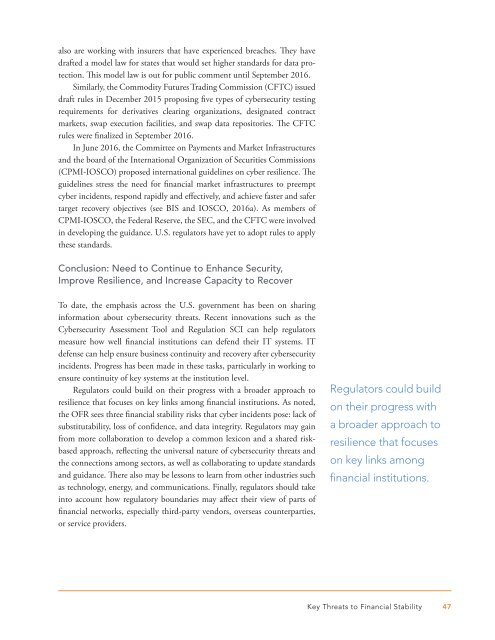OFR_2016_Financial-Stability-Report
OFR_2016_Financial-Stability-Report
OFR_2016_Financial-Stability-Report
You also want an ePaper? Increase the reach of your titles
YUMPU automatically turns print PDFs into web optimized ePapers that Google loves.
also are working with insurers that have experienced breaches. They have<br />
drafted a model law for states that would set higher standards for data protection.<br />
This model law is out for public comment until September <strong>2016</strong>.<br />
Similarly, the Commodity Futures Trading Commission (CFTC) issued<br />
draft rules in December 2015 proposing five types of cybersecurity testing<br />
requirements for derivatives clearing organizations, designated contract<br />
markets, swap execution facilities, and swap data repositories. The CFTC<br />
rules were finalized in September <strong>2016</strong>.<br />
In June <strong>2016</strong>, the Committee on Payments and Market Infrastructures<br />
and the board of the International Organization of Securities Commissions<br />
(CPMI-IOSCO) proposed international guidelines on cyber resilience. The<br />
guidelines stress the need for financial market infrastructures to preempt<br />
cyber incidents, respond rapidly and effectively, and achieve faster and safer<br />
target recovery objectives (see BIS and IOSCO, <strong>2016</strong>a). As members of<br />
CPMI-IOSCO, the Federal Reserve, the SEC, and the CFTC were involved<br />
in developing the guidance. U.S. regulators have yet to adopt rules to apply<br />
these standards.<br />
Conclusion: Need to Continue to Enhance Security,<br />
Improve Resilience, and Increase Capacity to Recover<br />
To date, the emphasis across the U.S. government has been on sharing<br />
information about cybersecurity threats. Recent innovations such as the<br />
Cybersecurity Assessment Tool and Regulation SCI can help regulators<br />
measure how well financial institutions can defend their IT systems. IT<br />
defense can help ensure business continuity and recovery after cybersecurity<br />
incidents. Progress has been made in these tasks, particularly in working to<br />
ensure continuity of key systems at the institution level.<br />
Regulators could build on their progress with a broader approach to<br />
resilience that focuses on key links among financial institutions. As noted,<br />
the <strong>OFR</strong> sees three financial stability risks that cyber incidents pose: lack of<br />
substitutability, loss of confidence, and data integrity. Regulators may gain<br />
from more collaboration to develop a common lexicon and a shared riskbased<br />
approach, reflecting the universal nature of cybersecurity threats and<br />
the connections among sectors, as well as collaborating to update standards<br />
and guidance. There also may be lessons to learn from other industries such<br />
as technology, energy, and communications. Finally, regulators should take<br />
into account how regulatory boundaries may affect their view of parts of<br />
financial networks, especially third-party vendors, overseas counterparties,<br />
or service providers.<br />
Regulators could build<br />
on their progress with<br />
a broader approach to<br />
resilience that focuses<br />
on key links among<br />
financial institutions.<br />
Key Threats to <strong>Financial</strong> <strong>Stability</strong> 47


